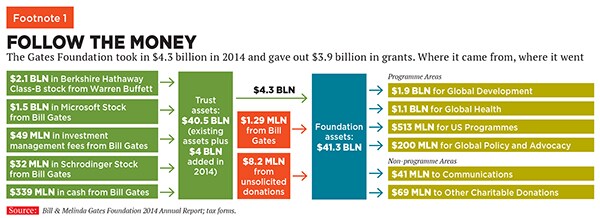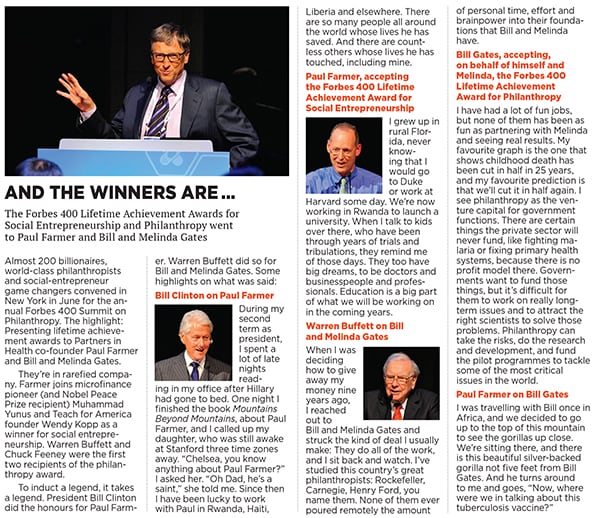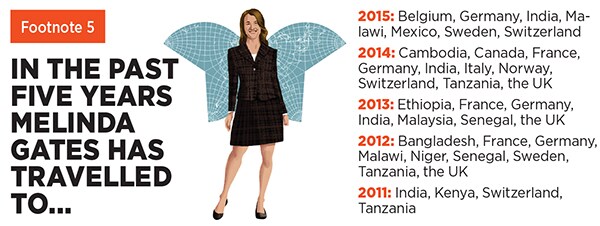
Melinda Gates: The first woman of women
Melinda Gates is exerting her influence over the richest charitable foundation in history. In doing so, she's quickly become the most powerful advocate for women and girls in the world
German Chancellor Angela Merkel invited one of the greatest collections of women leaders ever for a G7 meeting inside her vast concrete-and-glass Chancellery this September. You could find the director of the World Health Organization (Margaret Chan) and the CEO of General Motors (Mary Barra). The prime minister of Norway (Erna Solberg) and the former prime minister of Denmark (Helle Thorning-Schmidt). A Nobel Peace Prize winner (Liberian President Ellen Johnson Sirleaf) and a queen (Rania of Jordan).
And at a circular table set for about two dozen, sitting directly across from Merkel: A former Microsoft manager turned philanthropist, Melinda Gates.
After Merkel danke schöns her guests and listens to reports on women’s political participation, health and economic empowerment, she opens up the floor. Gates speaks first, giving a precise, impassioned four-minute address. “When you get women in roles of leadership, we make things happen,” Gates says. “It takes us using our voice, and it also takes us making investments, huge investments, in women and girls.”
Alone in this room of world leaders, Gates can single-handedly make that happen. Prime ministers have parliaments; CEOs have boards; Melinda Gates has a $41.3-billion endowment, and she can deploy it in pretty much any manner that she and husband Bill, the world’s richest person, see fit.
This represents a personal transformation. For the first decade and a half of its existence the Bill & Melinda Gates Foundation deployed its remarkable scale toward eradicating polio and malaria, and experimentation in education issues. But over the past few years Melinda Gates has embraced having her name on the letterhead of the largest-ever charitable foundation [1], along with the influence that comes with that. She has become the most powerful person on the planet whose singular focus is women and girls.
“I kept looking for the advocate who would champion these issues,” she says over lunch at the iconic Hotel Adlon Kempinski, during a break from Merkel’s forum. Gates, 51, has the air of a down-to-earth technocrat, travelling without an entourage but rather with reams of data and determination. “I knew it had to be a woman. I considered other women leaders. But I couldn’t find the one who embodied to me the voice of women around the world. And so I thought, ‘If I’m the one, then I just need to do it. I have to have courage and not worry.’”
Women account for six out of ten of the world’s poorest and two-thirds of the illiterate. “Excessive female mortality” in the developing world, in the parlance of the International Monetary Fund, means some 3.9 million women and girls are “missing” annually: About two-fifths are never born, one-sixth die in early childhood and more than one-third die during their reproductive years.
“What’s the most pressing issue of our time?” asks Gates. “It really is ending poverty in the world. And we know to do that you have to put women and girls at the centre.” Poverty is sexist, and Gates is betting billions that it can be stemmed through the gender historically ignored.
Melinda French Gates was born and bred in Dallas, the daughter of an aerospace-engineer father and a homemaker mother who helped run a family rental property business on the side. “That was literally how they were going to put us through college, and we all knew it,” she says referencing her sister and two younger brothers.
The valedictorian of her all-girls Catholic school and captain of her high school’s drill team, Gates earned a bachelor’s in computer science [2] and economics and an MBA from Duke in five years, consciously shaving a year so she could get into the workforce faster. “She always knew what she wanted,” says her sister, Susan French. “She just has this confidence within her. Once she sets her eyes on the next project, her next goal, then it’s all out.”

That next project, in 1987, was Microsoft, as a product manager, where the founder famously asked her out in the company parking lot. “I worked around a lot of really intelligent guys in college because there were very few women,” she says, describing her initial attraction. “When I look back, Bill was the same kind of guy I was hanging out with in college. I had a lot of respect for them, and they had respect for me. I was definitely attracted to his brilliant mind, but beyond that, his curiosity. And he has a huge sense of fun. I love that wry side of him.”
The couple dated for seven years before marrying in 1994 in Hawaii. In 1996 Gates, now a general manager at Microsoft, became pregnant with their first child, Jennifer, and chose to stay home. “That was completely her decision,” says Bill Gates. “I was a little surprised, but that really made sense for her. Then came kids two and three.”
Fast-forward two decades: Jennifer is now 19 and a sophomore at Stanford, with Rory, 16, and Phoebe, 13, leaning on Mom increasingly less [3]. Like many mothers staring down an empty nest, Gates went through a period of intense soul-searching. Now what?
And so she began digging ever deeper into the work at the Gates Foundation, which is concentrated primarily on global health and development, and making stunning progress in eradicating polio, malaria and HIV, and promoting vaccines and sanitation. It should be noted, though, that the foundation “has not been a pioneer when it comes to advocating for women’s health,” says Linsey McGoey, author of No Such Thing as a Free Gift: The Gates Foundation and the Price of Philanthropy.
Increasingly, Gates started focusing less on the foundation’s vertical efforts but rather on how to approach what it was already doing horizontally.
Specifically, to fund initiatives in these areas that take the world’s most vulnerable women and girls into account [4]. Yes, there was an empathetic component, but Gates looked through the lens of ROI. Muhammad Yunus won a Nobel Peace Prize for microloan practices that targeted women in the developing world, recognising they’re more likely to steward money effectively and channel it into the family. Bill Gates has saved tens of thousands of lives through immunisation efforts; Melinda Gates began to encourage grants that took into account that women are more likely than men to take their kids to get immunised.
“When I was first at the foundation, I thought of women’s issues as the ‘soft issues,’ and I didn’t want to be seen as soft,” says Gates. “In fact, it’s just the opposite. Women’s issues are the hard issues. You want to get at violence or child marriage? Those are hard. Warren [Buffett] always says you have to swing for the fences.”
Melinda Gates’s public coming out also traces to Berlin. For years, even as she worked at the foundation, she guarded her privacy. (“Bill was already a public figure, so I knew what that half looked like.”) But eventually she decided that advocacy for a cause means putting your face out there. So three years ago she came to Germany to give a TedX talk focusing on family planning and universal birth control access. Her original $70-million-a-year commitment was doubled three months later, and she has just announced an additional $120 million.
Welcome to the limelight, Melinda. The Vatican’s office newspaper, under Pope Benedict XVI, published a front page headline, ‘Birth Control and Disinformation: The Risks of Philanthropy’, that accused her of spreading lies. A tough rebuke for a Catholic who says she prays or meditates daily. “It’s a really uncomfortable place to go,” says Gates. “To talk about sex, reproduction, tools. But these were things we were talking about inside the foundation.”
And Gates learned two valuable lessons. First, that when she speaks, by dint of her conviction and resources, the world listens. “In giving voice to family planning, once I saw we could actually move resources on the global stage, I thought, ‘There are other women’s issues I have to take on.’” Second, she could take a punch.
“They say how mistaken Mrs Gates was, and she must have been misled by the people who wanted to make money selling reproductive health tools,” says Bill Gates. In response he gave her the newspaper as a gift, which she keeps framed in her office at the foundation’s Seattle headquarters. “I gave her a copy because she decided she would speak up and deal with the controversy. It’s a complex area, but she took it on.”

Those who watch the foundation reject the idea that Melinda operates as a number two to Bill’s number one. “Anyone who’s paying attention understands that she’s playing a leading role,” says Aaron Dorfman of the National Committee for Responsive Philanthropy, a watchdog for the sector.
“We certainly weren’t working as equals when we started together,” says Melinda Gates. “I was down several levels at Microsoft, and he was the CEO. We’ve had to change to be coequals. It’s not something that happens overnight, but we’re both committed to it. We needed to talk behind the scenes when it wasn’t working. But I think that’s come now.”
“We literally hand meetings and issues to one another, and we’re very comfortable about when to make a decision without the other one and when we should do it together. And the together isn’t always because of a dollar issue. It’s more about, ‘Will the other person care about this decision as much as I do?’ ”
|
“Everything I’ve ever done, I’ve always had a partner,” says Bill Gates. “In the early days of Microsoft it was Paul Allen who helped come up with the ideas. Then it became Steve Ballmer, who helped run the company and made it supersuccessful. Now it’s Melinda at the foundation.”
She carries the same title as her husband: Co-founder and co-chair. (Bill’s dad is another co-chair and Warren Buffett, who is funnelling his fortune into the foundation, serves as co-trustee.) “She and Bill are the final deciders,” adds Susan Desmond-Hellmann, the foundation’s CEO, who started last year. “The approval process that starts with annual budgets and strategies involves the two of them as equal partners.”
Gates’s family planning initiatives quickly segued to those who got pregnant, specifically maternal and prenatal health. Once you spend time there, infant health is a natural extension. Then a commitment to expand educational opportunities for girls. And what are these young women supposed to do when they get out of school? Gates understands most aren’t going to get paid to work in developing countries. So she’s green-lit numerous programmes that encourage micro-entrepreneurship, such as small-plot farming and mobile banking.
The result is a cradle-to-motherhood suite of initiatives for women and girls. The foundation doesn’t break out how much it spends in this area, mostly because it was so woven into its $3.9 billion in outlays last year. And it measures how each programme specifically helps women and girls.
For example, the foundation backs M-KOPA, a Kenya-based organisation that manufactures solar-powered lamps. On paper it’s a gender-neutral programme providing personal power supply that relieves off-the-grid families of the costs and dangers of kerosene lamps. But it helps girls, who often do homework at night after a day of chores.
Another partner, GSMA, brings mobile money accounts to the underbanked. Again, a bigger deal for women—just 37 percent in developing countries hold bank accounts, and many are intentionally excluded from formal financial systems.
“When you go on the ground, in places in India or inner Bangladesh [5], you don’t want to hear what the women tell you,” she says. “But when you really sit and take it all in, you later go, ‘Oh my God, they’re right.’ And this group of women helped me realise that all these other issues I see in the developing world need to be addressed, too. They’re all part and parcel of the same thing.”
The Gates Foundation is also keen on funding pilots in this area: Successes are rewarded with more money; failures are learning opportunities. Megan White Mukuria is typical. She founded Kenya-based ZanaAfrica Group, an initiative focussed on sanitary pads. Girls in many low-income countries stay away from school during their period or even drop out.


ZanaAfrica’s grant timeline neatly follows the arc of the foundation’s gender focus. After a $100,000 test-phase grant in 2011 to develop sanitary pads from local materials such as bamboo or jute, Mukuria was turned down for a Phase 2 proposal to test distribution strategies and approaches to health education. That “no” went to “maybe yes” two months later and turned into a definite $1 million three months after that. Last month ZanaAfrica received a $2.6-million grant.
“They [the Gates Foundation] initially couldn’t fund the scale-up because sanitary pads are outside their mandate in sanitation, which is all about the toilet,” Mukuria says. “But they literally just winked at each other and said, ‘We have to do this.’”
Expect more such grants next year through a loquaciously named programme: Putting Women and Girls at the Center of Development Challenge. Some 20 awardees will net more than $20 million in grants aimed at gender-specific projects. Small money for Gates but a signal that she’s opening up to groups that see women and girls as the primary goal rather than a beneficial by-product, and a first step toward what Gates hopes might be a clearing house for those looking to help in this area.
“Everyone tries to read the tea leaves to understand what’s going to be in favour or out of favour,” says Dorfman, the philanthropy watchdog, “and many groups adjust their work plans accordingly.” That dovetails with a consistent criticism of the Gates Foundation—that it wields too much power and makes too many decisions in an echo chamber. “Whether Mr and Mrs Gates prefer it that way or not,” says the author McGoey, “there’s this perception that the strong directional influence played by the executives is something to be celebrated rather than seen potentially as a cause for problems.”
“My experience has been that she [Melinda] likes to get [others’] views,” says Desmond-Hellmann. Asked if anyone says no to Melinda Gates, she laughs. “People do say, ‘Yes, that’s not possible.’ That’s more likely than no.”
“[We are accountable] to the people of the world,” adds Gates. “I hope that at the end of our lives somebody will look back and say, ‘Melinda and Bill set out to change the world on behalf of the poor. Did they? Are more kids alive because of the work they did? Are fewer people getting malaria? Are more women getting contraceptives?’ That’s who we are accountable to.”
Back in Berlin, after a state dinner at the Chancellery, Gates heads off to her private jet. Across town from the airport and a world apart from the halls of power she just left is a government complex where thousands of Syrians and other refugees are waiting to register for asylum.
It’s impossible to ignore all the women tending to overstretched strollers filled with little ones and a life’s detritus sagging in plastic bags. They have their own tent for privacy, including nursing. Men stand in overcrowded lines, anxious to be called to sign up for IDs, funds and services. Having trekked to Berlin, the refugees have nothing to do but wait.
“When you see a picture of a child washed up on the beach—or a mother—so many of the faces you see are women,” she says. “And even if they get across the border, they’re put into camps, which are especially horrible for women in terms of the violence and rape. They’re disproportionately affected. So my heart breaks.”
The Gates Foundation is engineered to move quickly—the couple has dictated that all assets must be put to work and the organisation wound down within 20 years of the last co-founder’s passing. So Gates is investing some $17.5 million around the Middle East refugee crisis—an investment the world sees as alleviating suffering, and that Melinda Gates sees as another step in improving the lives of poor women.

(This story appears in the 30 November, -0001 issue of Forbes India. To visit our Archives, click here.)







